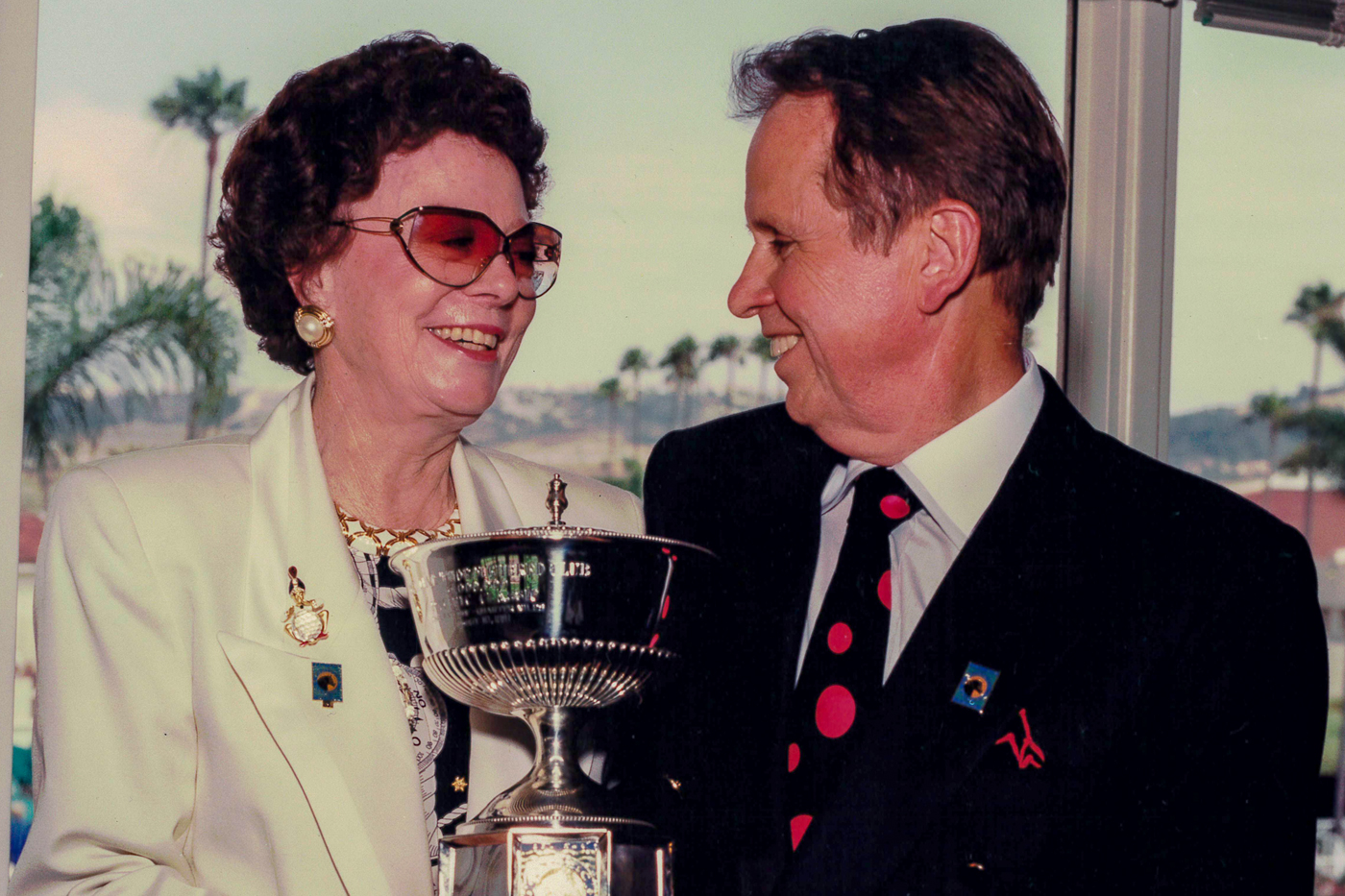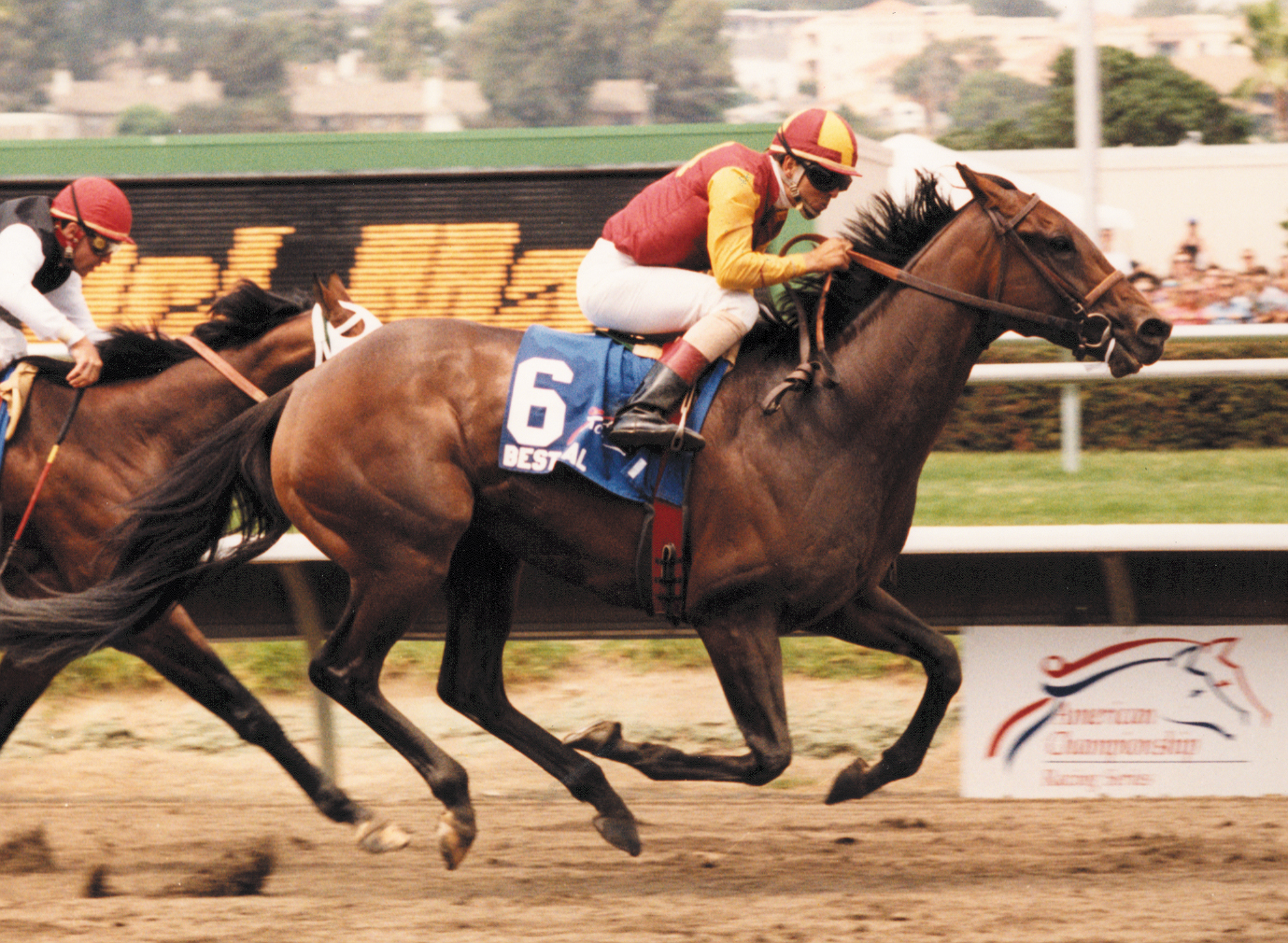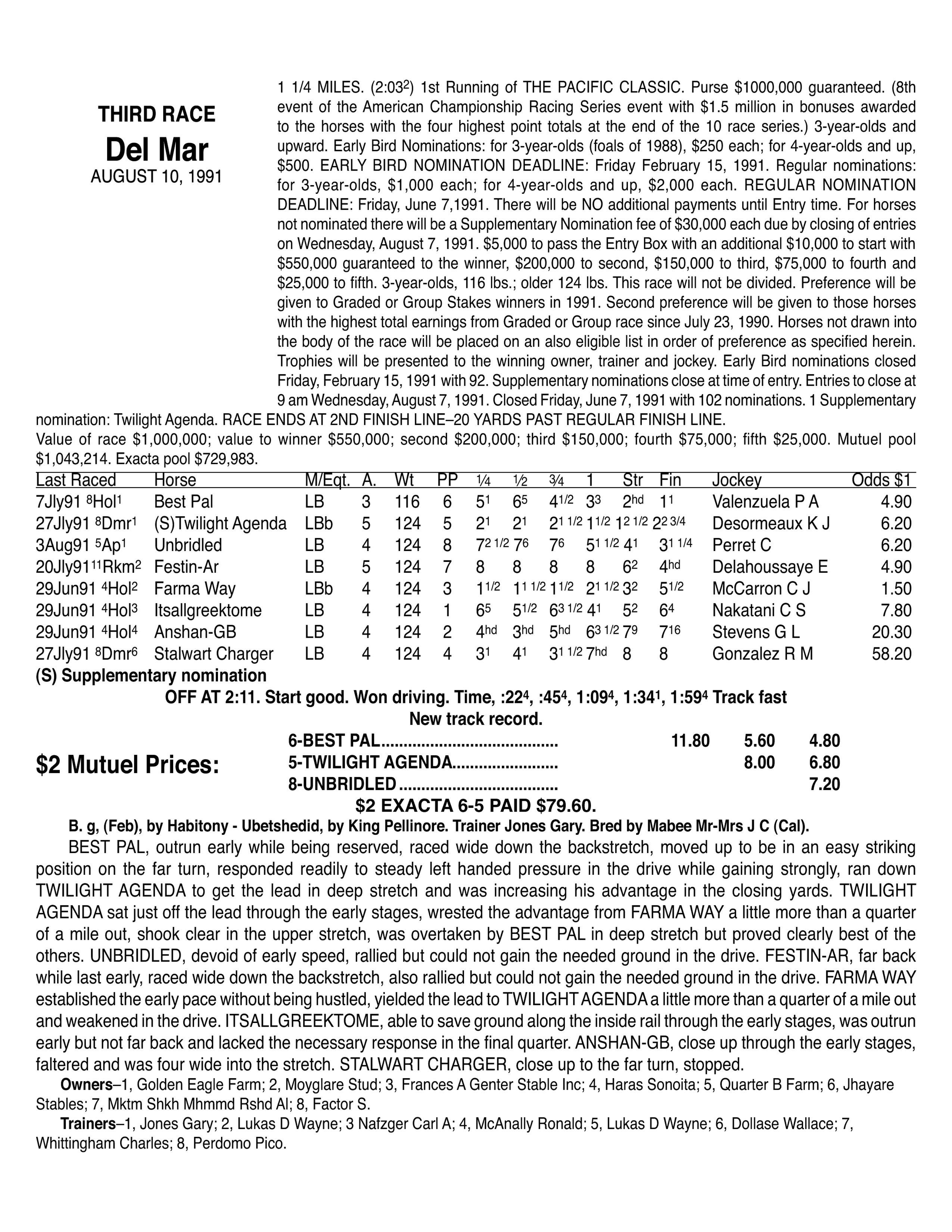
John & Betty Mabee with 1991 Pacific Classic Trophy © Broadman Photo
In 1991, Operation Desert Storm begins in Iraq; the top selling novel, The Firm by John Grisham, is published; the film “The Silence of the Lambs” is released in theatres; the LA riots break out; “Dances With Wolves” wins the Oscar for best picture; the first ever web site, info.cern.ch, is created; Super Nintendo is released with a price tag of $200; Magic Johnson reveals he is HIV positive; Freddie Mercury dies, and Disney releases “Beauty and the Beast.”
Meanwhile, in the small seaside hamlet of Del Mar big things were brewing that would add another jewel to that year. John Mabee, the president of the Del Mar Thoroughbred Club, wanted a signature race for the summer meet. Joe Harper was his general manager at the time.
“John Mabee was one of the leading guys in the country with horses in training,” Harper recalls. “He loved the game and had a nice farm (the Golden Eagle Farm) out there (in Ramona). Mabee was a wonderful guy. He was smart. He was from the midwest and Betty (his wife) was terrific. They were a good team.
“He said ‘Joe, we need a million dollar race,’” Harper continues. “He asked, ‘Can we do it next year?’ and I told him no we needed to negotiate. For the next three years it was “Joe, where’s the million dollar race?’”
This was in the late 80’s and plans were already in motion to replace the old grandstand – first built in 1937 - at the Del Mar Fairgrounds. The Thoroughbred Club was working to come up with enough money to finance the job.
“The purse structure had been going up for a couple of years,” Harper recalls. “Probably not much more than inflation but at least it was up. But it wasn’t up enough to where we could dump that much money into the stakes schedule because we had to negotiate a percentage of the stakes to overnights. The HPBA in those days didn’t want all the rich guys getting all the money, which we understood.”
Money was moved around, negotiations led to agreements, and in 1991 things were in place for John Mabee’s signature race.
“The pressure was there,” Harper remembers. “I don’t think he (Mabee) wanted to tell me to do it. We went and got our stakes schedule okayed and finally, I told him we got it and I asked him if he had a horse he was thinking of. He said ‘I might’.”
Tom Robbins was then the racing secretary and director of racing at Del Mar. It was his job to come up with the structure of the race and find the horses to run in it.
“We looked at the calendar because we wanted to make sure we weren’t doing something at that time that was going to interfere with other races around the country,” Robbins says. “Cognizant of what the national schedule looked like. At the time I was part of the graded stakes committee and we were always conscious of the big races. (There was) the Arlington Million and we wanted to stay away from the Travers at Saratoga.”
Del Mar was doing well at that time thanks in large part to the introduction of off-track wagering.
“We did have some money to fund a race like that,” Robbins remembers. “It was several years after we had inter-track wagering. People in LA could now bet on Del Mar so we had additional purse money. Purse levels prior to that, say 1986, were considerably lower than Santa Anita and Hollywood Park. Intra-track wagering in California helped fund Del Mar for the summer, then our purses became higher than Santa Anita and Hollywood Park.. We couldn’t have done it five years prior.”
You have to realize that at this point in time Del Mar did not have a marquee race. Santa Anita had the ‘Big Cap’ and Hollywood Park the Gold Cup.
“There really wasn’t,” Robbins recalls. “We had the turf races but nothing that stood out. We had the Debutante and the Futurity that we ran at the end of the meet but we just didn’t have significant purse money. We satisfied the minimum standards for the Debutante and Futurity and they became important races on the national calendar.”
That was all about to change. Robbins set out to find the best dirt horses. In 1991, there wasn’t the competition for big name horses that you have today. Fast forward to 2024 and the NYRA has the Travers and the Jockey Club Gold Cup, both million dollar races, on back-to-back weekends.. Charles Town, a small track in West Virginia, just ran a $1 million race.
“This was before some of the smaller racetracks had racinos,” Robbins contends, “and were able to sink more money into their purse structures.”
After all of the research and scrutiny, they finally settled on a date, Saturday August 10.
“We were hoping to get the best horses on the west coast,” Robbins says, “and we were encouraging people well in advance of the race to make sure they were aware of it. We were telling them to use the San Diego (Handicap) as a race they could prep in if they needed to run.”
So now they had the money and the date, but what were they going to call this thing?
“Dan (Smith) came up with Pacific Classic,” Robbins says. “Brilliant. I loved it. It was perfect.”
Dan Smith was then the director of media at Del Mar.
“I wanted to find a name that indicated a location,” Smith remembers. “The other part of it was the race was going to be contested at a classic American distance on the dirt of a mile and quarter and the class that would go with the name.”
Hence, the Pacific Classic was born. It was unique in the way that it had weight-for-age conditions. Top weight for an older horse was 124 pounds, for a 3-year-old it was 116. It didn’t matter how much a horse had earned. It wasn’t like a handicap.
“I was 110 percent behind it,” Smith recalls. “Del Mar for years and years was the stepchild of Santa Anita and Hollywood Park. But that changed once the Thoroughbred Club came along and started investing in the plant. We started getting better quality racing and pretty soon we were on equal footing. There were already two one-million-dollar races, the Santa Anita Handicap and the Hollywood Gold Cup. So the Pacific Classic became the third million dollar race in California. It made a lot of sense.”
Now it was up to Smith and everyone else at the Del Mar Thoroughbred Club to build interest around the race, both locally and nationally.
“We hustled the race pretty good,” Smith contends. “I was dispatched to Gulfstream to solicit nominations. I went back to Florida and went out in the barn area for two or three days in a row talking to trainers about nominating. The horse I was looking for was Strike the Gold, the Kentucky Derby winner that year. I remember going by Nick Zito’s barn. He was very nice about it but he said the owners wanted to stay on the east coast. The racing office dispatched somebody to the east coast to solicit nominations and someone else to Chicago.”
Their work paid off. 102 horses were nominated to the race.
Meanwhile, closer to home, the marketing department worked overtime to get the word out on Del Mar’s first million-dollar race.
“In conjunction with the race itself we had a weeklong festival called the Classic Festival,” Smith notes. “We invested a lot of resources into it for advertising. We had banners up along the main drag on the Fairgrounds. Banners up in Del Mar on highway 101.”
There was just one small detail that had to be worked out. It had to do with the layout of the race and the distance.
“Okay, (we have) a million dollar race,” Harper remembers. “How long? Everybody said it had to be the classic distance (a mile and a quarter) and I’m looking at the track wondering ‘And we’re going to start it where?’”
The chute on the west end of the track was too short, meaning to get the full ‘Classic’ distance, the race would have had to start on the turn.
“We had to create another finish line because the chute did not allow you to run a full mile and a quarter,” Smith adds. “It was called the Crosby course and it was 120 feet short of a mile and a quarter. So we created a second finish line.”
It was 120-feet farther east down the stretch, nearly half the distance between the existing finish line and the first turn. As with all thoroughly thought out projects, they had a test run to make sure everyone was onboard with the change.
“We ran a race just to get the jocks familiar with it,” Smith recalls. “They come down the lane and Eddie Delahoussaye stood up too soon. For years we ran a mile and a quarter less than 120 feet and no one knew where the short quarter was, the first quarter or the last quarter.”
With all of the kinks ironed out, it was time to run the race. When race day came, interest was high.
“The press box was jammed,” Smith says. “It was the third race on the card because it was nationally televised.”
Eight horses went to the gate that afternoon. Two were outside invaders, Festin, who had won the Oaklawn Handicap earlier in the year and would go on to win the Jockey Club Gold Cup, and Unbridled, winner of the Kentucky Derby and the Breeders’ Cup Classic in 1990.
The local contingent was led by Farma Way, who had won the Santa Anita Handicap and the Pimlico Special earlier in the year and was the favorite in the race. Twilight Agenda, who had won the San Diego Handicap and a month later would win the Del Mar Handicap was also in the race in addition to Itsallgreektome, Stalwart Charger, Anishan and the 3-year-old Best Pal.

Best Pal 1991 Pacific Classic © Broadman Photo
“Best Pal was a marquee draw,” Smith relates. “He had won the Futurity so he was a popular horse here in San Diego. And P Val (jockey Patrick Valenzuela) was a perfect fit. P.Val put him in the race. He knew the horse’s idiosyncrasies. The race was good. Best Pal beat Twilight Agenda and my recollection is that he needed that extra distance to the second finish line. He got him late.”
“Best Pal had run second in the (Kentucky) Derby,“ Harper says. “We were all rooting for him. We were rooting at first and then we were all screaming and shouting and jumping up and down. When John and Betty got up to go down (to the winners circle) the whole Turf Club turned around and applauded. They both had tears in their eyes.”
The Turf Club was packed as well as the grandstand and the tarmac. Attendance that day was 28,134.
“It’s still the magic number for this grandstand,” Harper notes. “Those crowds always bothered me. ‘Oh wow, isn’t that great,’ but I’m looking at the lines that aren’t moving. This is not that comfortable. But the only things tracks were being measured by then was attendance and handle.”
Handle for the day was over $11 million. When it was over, Robbins remembers feeling relief and excitement.
“It went pretty smoothly,” Robbins contends. “To get national coverage on an event like this was significant at that point.”
“It was a joyous time for everybody who worked here because we all liked the Mabees,” Harper says. “Best Pal became a beloved horse. He eventually went back to (Golden Eagle Farm) and then a few years later passed away. John asked me to officiate at the funeral. I went out to the farm and I looked out and there were thousands of people. They came to say goodbye to Best Pal.”
It’s been 34 years and the Classic has become one of the major races on the national calendar. Breeders’ Cup uses it as a ‘Win and You’re In’ for their Classic. Hall of Fame horses, legendary farms and Hall of Fame trainers have come out and run in it.
“Historically, Seabiscuit and Ligaroti put Del Mar on the map,” Smith states, “but this race elevated perception of the product at Del Mar tremendously.”

